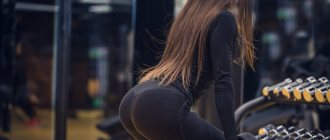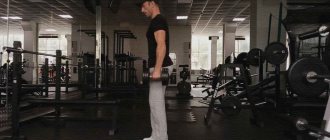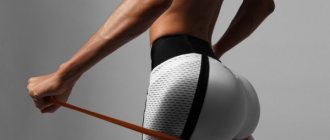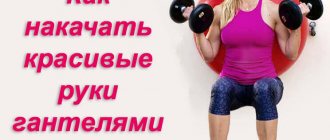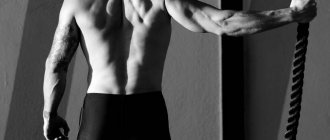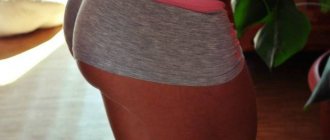Genetics largely determines our appearance, but do all those with beautiful buttocks have Brazilian roots? Of course not.
A clear understanding of your body type will help you build a training plan and diet, regardless of your individual characteristics.
Egor Fukalov
fitness trainer
Offers to try training for firm buttocks at home.
Photo: istockphoto.com
Don’t rush to blame everything on nature and give up training. Some are less fortunate with genetics, but they have incredible shapes. On the other hand, many girls with genetically beautiful buttocks do not have toned relief.
Round buttocks - genetics or work?
We would like to please you that muscles can be increased in size and made to the volume that you will be satisfied with. The gluteus maximus muscle is one of the strongest and largest muscles in humans, so it quickly and noticeably increases in volume.
How to make your daily squats as effective as possible?
Types of buttock surgery
The method of correction of the buttocks is determined in accordance with the task, the volume of impact, and the physical parameters of the patient.
There are several ways:
- buttock lift (without endoprosthetics).
- gluteoplasty (shape correction, buttock augmentation with implants;
- thread correction of the buttocks.
Surgical butt lift
There is no universal surgical access for plastic surgery of the gluteal region. The incision area is determined by the purpose of the intervention. So, to correct drooping, long, asymmetrical buttocks, a median (medial) or lower incision is made. For trochanteric sagging, it is more effective to use a lateral or superior incision (Pascal's incision).
Through the incision, the plastic surgeon excises excess soft tissue, tightens and fixes the muscles, then closes the incision area with cosmetic sutures. If necessary, the lifting procedure can be performed simultaneously with liposuction or with surgery on the outer or inner thighs (buttock and thigh lift).
The operation is performed under general or local anesthesia for 2-2.5 hours.
A butt lift provides a significant rejuvenation effect in a given area, maintaining the result for 10 years or more (in the absence of weight fluctuations). However, the method also has significant disadvantages: long recovery, postoperative scars, for example, the inability to correct the shape of flat or severely drooping buttocks.
Buttock surgery. Photo before:
1 Before buttock surgery
2 Before buttock surgery
3 Before buttock surgery
Buttock surgery. Photo after:
1 After buttock surgery
2 After buttock surgery
3 After buttock surgery
Buttock enlargement
The gluteoplasty technique involves the use of silicone implants. They are round, oval and teardrop-shaped (anatomical). Round and oval endoprostheses are well suited for enlarging the buttocks and giving them roundness. Anatomical implants are chosen when it is necessary to correct aesthetic defects (asymmetry, deformation of the buttocks).
The implant is installed through a small incision in the sacral area in the natural intergluteal fold. The endoprosthesis is placed under the muscle that holds it and does not allow it to move along the buttock, or under the superficial gluteal fascia to ensure maximum naturalness. Buttock surgery is often combined with liposuction and hip correction (this technique is also called body lift).
After placing the endoprostheses, the surgeon places cosmetic sutures on the incisions (usually self-absorbable material is used) and, if necessary, installs drainage.
The operation takes about 1.5-2 hours and is done under general anesthesia.
Buttock lift with threads
A thread lift, often called a Brazilian lift, is used in cases of slight ptosis of soft tissues and skin and in the presence of cellulite.
Through micropunctures, threads are placed under the skin using cannulas, which are fixed in the soft tissues using special notches or cones. After installing the threads, the surgeon tightens the soft tissue to them and secures them in a new position. If necessary, a thread lift is combined with lipofilling or liposuction.
The intervention is performed under local anesthesia for 1 hour.
The advantages of the method include quick rehabilitation and the absence of scars. The disadvantages are the short duration of the effect (from 3 to 5 years).
How to make your gluteal muscles grow?
- Eat enough protein, fat and carbohydrates.
- Do workouts to increase muscle mass.
- Recover fully after your workout.
- Use additional weights.
- Constantly but gradually increase the load.
To track your results, take measurements with a tape measure every month. This will allow you to see progress from your efforts.
Photo: istockphoto.com
You eat little protein and carbohydrates
To build muscle, the body needs building material - protein, which enters the body with food. Carbohydrates are also necessary: they provide the production of anabolic hormones necessary for muscle growth.
Aim for Evidence‑based recommendations for natural bodybuilding contest preparation: nutrition and supplementation to consume 1.8–2 g of protein per 1 kg of body weight. That is, if you weigh 60 kg, you need to eat at least 108 g of protein. For carbohydrates, consume 4–7 g per 1 kg of body weight.
Choose foods rich in fiber: cereals, whole grain bread, vegetables and unsweetened fruits. And avoid starchy and sweet foods, otherwise you may go overboard with calories and increase the amount of fat instead of muscles.
Include in your diet
